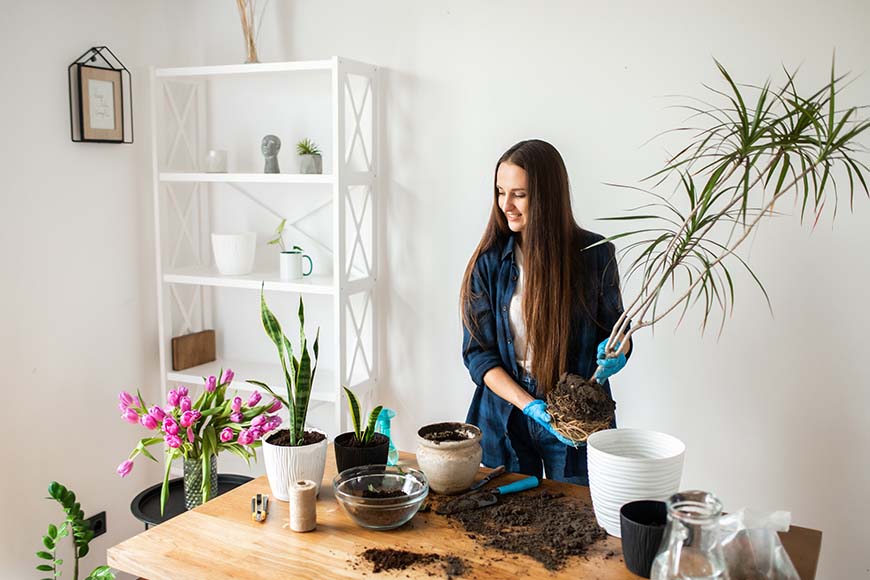
To become a great house plant parent is to master the art of the soil. It's really not even soil, but a soilless medium made up of different components and often made to tailor to each individual plant's need.
There are components meant to provide water retention such as coconut coir, sphagnum moss, peat moss, and slightly vermiculite. The latter of the three starts to cross over into components that provide drainage.
Drainage is super vital, providing oxygen down to the roots through the flow of water during watering. But even having good drainage will not support the best of house plants. We need to also have fluff in our soil, and this is where we use perlite.
Almost all nurseries use perlite, and it is in most potting mixes on the market we see today. It keeps soil mixes light, fluffy, and airy to allow the flow of water and the exchange of gases to root systems. Perlite is manufactured by the heating volcanic glass to extreme temperatures.
In larger pots, especially over 12 inches, bark chips are often used to help provide structure while allowing drainage and water retention. Bark chips will also add long term nutrient release to the roots, breaking down slowly before repotting.
Sand and sometimes grit are the last of drainage components in potting mixes, although others may be included, these are the biggies. Large bits of sand such as grit can help provide drainage while adding weight to the container, which is very important when growing larger size trees in containers.
Often gardeners like to add rocks to the bottom of the pot to provide drainage and weight. This is a great idea because some plants can grow pretty fast and large. They will grow large and topple over in a small pot, with only light materials such as perlite, sphagnum, and peat, resulting in damage to valuable branches or leaves.
This is where I have found it beneficial to add some small gravel or grit. It comes in a range of sizes, fine sand up to coarse grit or gravel. These materials can add extra weight and kept the pot heavy when the soil dries out.
More popular lately is the use of charcoal in soil mixes. Charcoal provides drainage, helps limits odors, and can provide structure for microbial life, which is beneficial to soil and plant health. I like the lightweight characters of charcoal, which resemble the size or bigger of bark chips but provide the drainage of perlite.
Also vital to plants is the addition of nutrients though liquid fertilizers or by Supplementing nutrients into the soil such as compost. Most people have access to the ability to provide compost at home. Composting using an outdoor compost bin or a worm tower is becoming more and more popular in the urban agriculture systems, as well as backyards and apartments.
There are many kinds of compost out there if you choose to make it at home. Almost everything is out in the market, from spent mushroom substrate and mushroom compost to worm castings, frass, bat guano, and other animal manures. Compost of almost any origin is going to add organic matter and nutrients to a soilless mix while holding on to moisture.
In some studies, soil mixes using up to 50% worm casting were found to be beneficial to plants. But too much of an unfinished compost can attract pests and disease to your pot and then your plant. So, use sparingly and learn what works for the plants and mixes you are working with.
Beyond compost are materials such as blood meal, bone meal, and greensand, which carry the weight of providing nitrogen, phosphorus, and potassium to plants. Which are the big three nutrients plants need to at least live. Some fertilizers like green sand provide additional minerals to the soil with products such as fish meal can be close to a complete feed.
To thrive, plants need everything down to magnesium and calcium, with the main three being nitrogen, phosphorus, and potassium. Many products are out there that have ratios of NPK that provide an overall balanced meal for plant health. Other mixes are specifically produced for a group of plants or specific plants that providing the additional micronutrients needed.
In the end, making and mastering a good potting soil is knowing the desires of your plant you are housing in that container. Growing cacti in the same mix you would for an orchid has negative consequences. Having at hand the base ingredients and the knowledge of what each plant wants will help you in your quest to becoming that amazing house plant-parent
